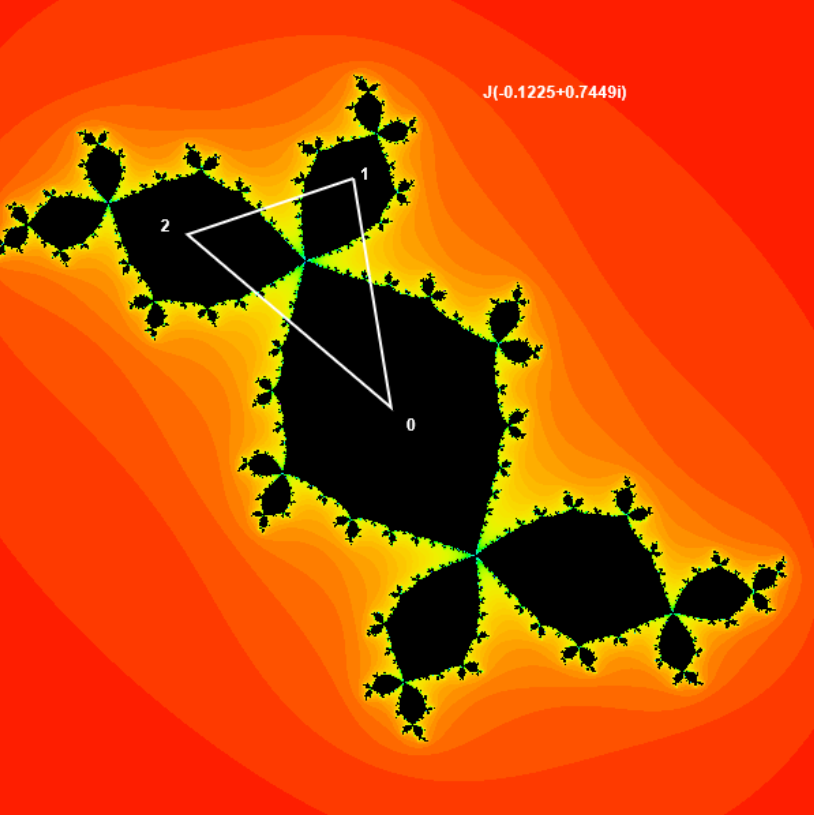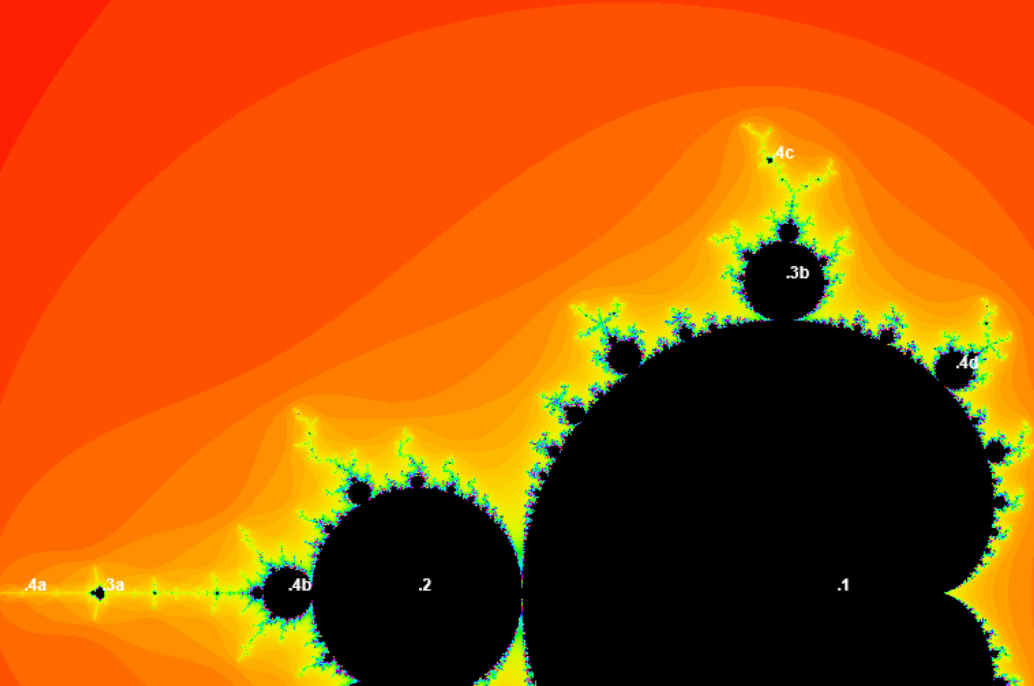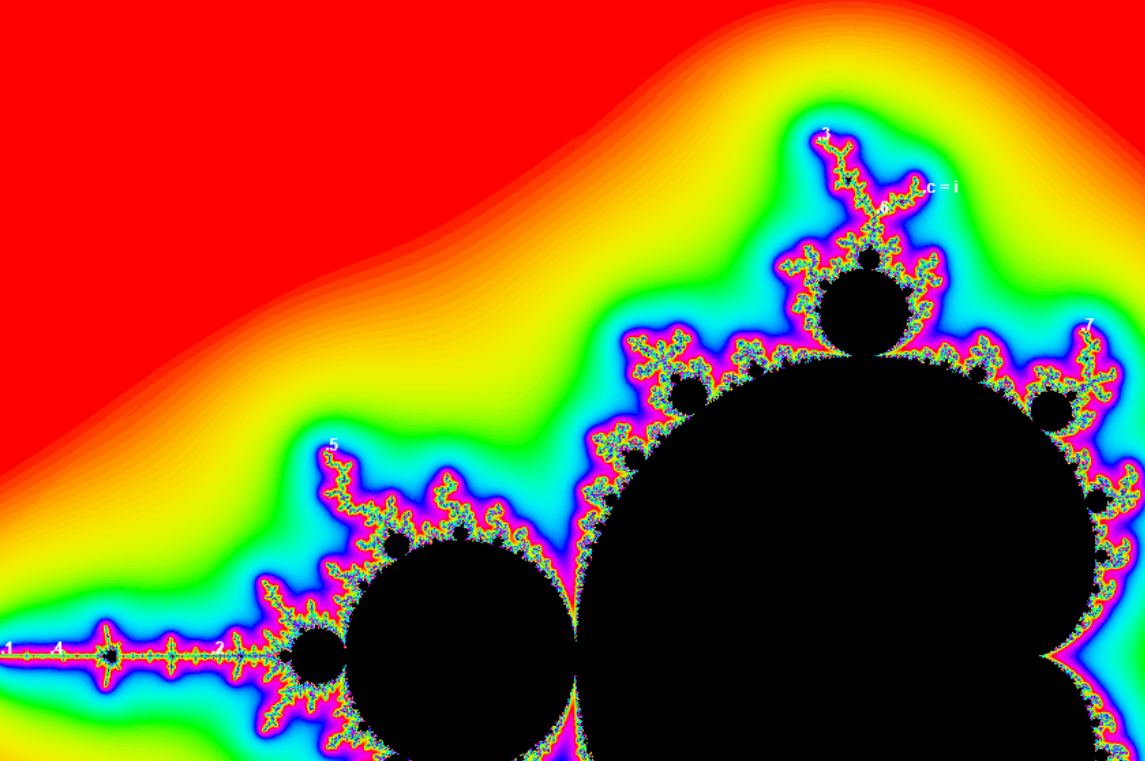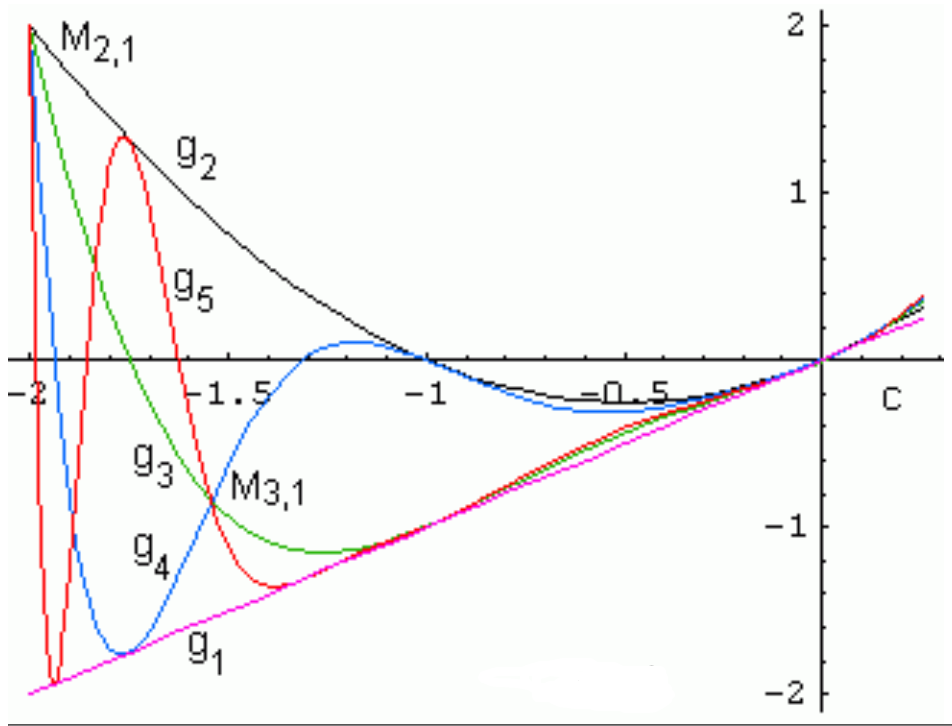6.1: Periodic and preperiodic points in the M-set
- Page ID
- 102268
Periodic points in the Mandelbrot set

A point c in the Mandelbrot set is periodic point with period n if its critical orbit is periodic with period n, i.e. gn(c) ≡ fcon(0) = 0. To the left you see periodic critical orbit with period 3. For example:
g1(c) = fc(0) = c = 0
c1 [1] = 0
g2(c) = fco2(0) = c2 + c = c (c + 1) = 0
c1 = 0, c2 [2] = -1
g3(c) = fco3(0) = (c2 + c)2 + c = c (c3 + 2c2 + c + 1) = 0
c1 = 0, c2 [3a] = -1.75488, c3 [3b] = c4* = -0.122561 + 0.744862i
g4(c) = fco4(0) = 0
c1 = 0, c2 = -1, c3 [4a] = -1.9408, c4 [4b] = -1.3107,
c5 [4c] = c6* = -0.15652 + 1.03225i, c7 [4d] = c8* = 0.282271 + 0.530061i

The number of such points doubles for each successive value of n because gn(c) is a polynomial in c of degree 2(n-1). It is known that it always has 2(n-1) distinct roots. If cn is a periodic point, then cn* is periodic too. It is evident, that every M-set bulb contains periodic point and corresponding J-set has superstable period-n critical orbit. This point is the nearest to the bulb "center" root of fc on(0) = 0 and it can be found e.g. by the Newton algorithm.
Preperiodic (Misiurewicz) points in the Mandelbrot set
A point Mk,n in M is preperiodic with period n if its critical orbit becomes periodic with period n after k (a finite number) steps. It is evident, that preperiodic points Mk,n are roots of equation:
fcok(0) = fco(k+n)(0) or gk(c) = gk+n(c) .
We have seen before that for given c the fixed points z1 = 1/2 ∓ (1/4 - c)½ (i.e. period-1 orbits) have multipliers λ1 = 2z1 = 1 ∓ (1-4c)½. Therefore any preperiodic point Mk,1 with period 1 has multiplier
λ1 = 1/2 - (1/4 - Mk,1 )½ .
The plus sign corresponds to the only preperiodic point M2,1 = -2 (the tip of the Mandelbrot set antenna or the crisis point) with the multiplier λ = 4 . As since multiplier of period-2 orbit is λ2 = 4(c + 1) therefore multiplier of period-2 Misiurewicz point Mk,2 is
λ2 = 4(Mk,2 + 1) .
Two examples are M2,1 = -2 and M2,2 = i. Its critical orbits are
(0, -2, 2, 2,...) and (0, i, i-1, -i, i-1, -i...)
respectively and their periods are 1 and 2. The orbits are repelling. To see this, the relevant multipliers are
λ1(-2) = 4 and λ2(i) = 4(1 + i)
and all of these have absolute value exceeding 1. Preperiodic points are not in a black region of M because there are points arbitrarily close that do not belong to M.
Here are some preperiodic points with period 1. All these points lie outside the main cardioid and the relevant fixed points are repelling.
| num | k | c | |λ| | Arg(λ)o |
| 1 | 2 | -2 | 4 | 0 |
| 2 | 3 | -1.54369 | 1.67857 | 180 |
| 3 | 3 | -0.22816+1.11514i | 3.08738 | -23.126 |
| 4 | 4 | -1.89291 | 1.92774 | 180 |
| 5 | 4 | -1.29636+0.44185i | 3.52939 | -5.7209 |
| 6 | 4 | -0.10110+0.95629i | 1.32833 | 119.553 |
| 7 | 4 | 0.34391+0.70062i | 2.45805 | -30.988 |

Real periodic and preperiodic points

For real c real polynomials g1,2,...,5(c) are shown in Figure \(\PageIndex{4}\) Real periodic points are roots of these polynomials. An intersection of two curves gk(c) = gk+n(c) corresponds to a Mk,n preperiodic point (M2,1 and M3,1 are shown here). Thus Fig.1 let us classify all periodic and preperiodic points in a simple visual way (at least for small n).

